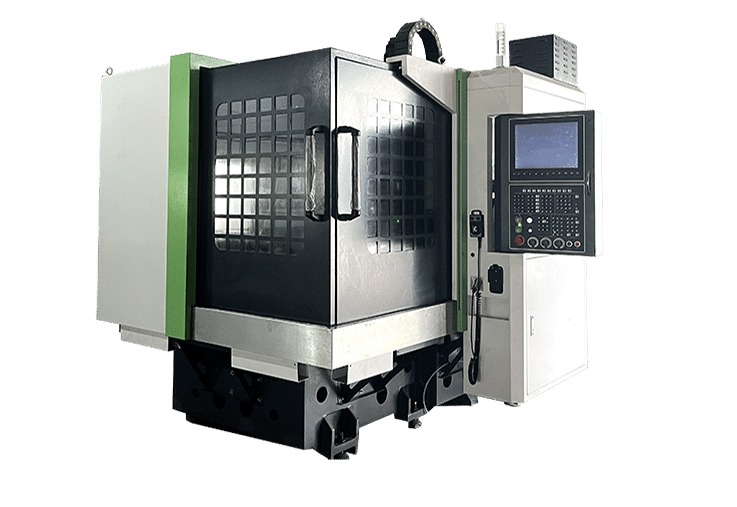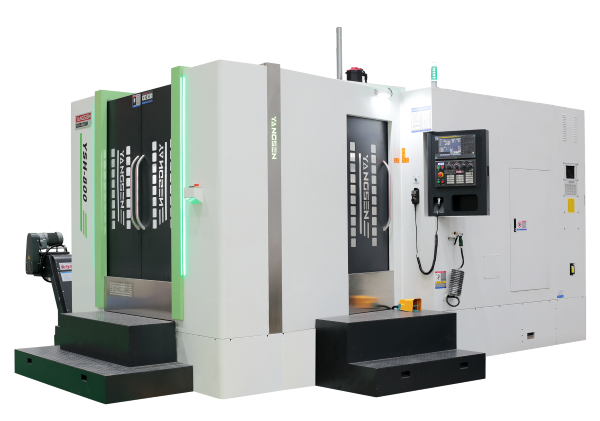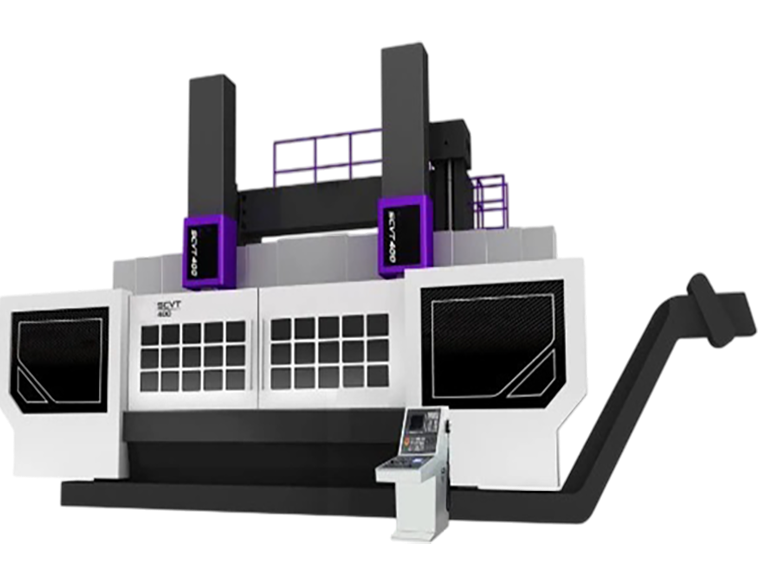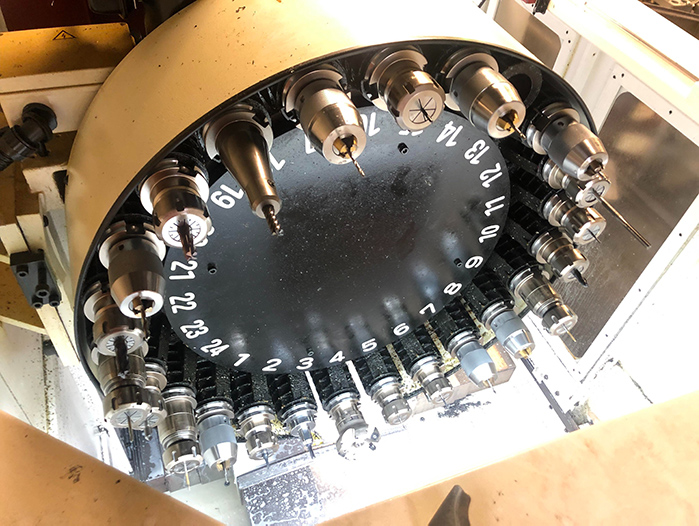コンピュータ数値制御(CNC)マシンは、現代の製造業の基盤となり、精密で自動化された効率的な加工プロセスを可能にしています。自動車、航空宇宙、エレクトロニクス、一般エンジニアリングなど、様々な業界で使用され、高精度かつ均一な部品を製造しています。
様々な種類のCNC工作機械を理解することは、特定の生産要件に適した機器を選択する上で非常に重要です。フライス加工機、旋削加工機、穴あけ加工機、研削加工機、切削加工機など、それぞれのカテゴリーは異なる目的を持ち、精度、速度、材料適合性といった点で独自の利点を備えています。
CNC工作機械(コンピュータ数値制御工作機械)は、コンピュータプログラミングを用いて高精度な加工操作を制御する自動化ツールです。CNCシステムは、機械工が手動で操作する代わりに、コード化された命令(多くの場合Gコードで記述)に従って、切削工具やワークピースを定義された経路に沿って移動させます。
CNC工作機械は、フライス加工、旋削加工、穴あけ加工、研削加工といった複雑な製造工程に広く利用されており、メーカーは優れた精度、再現性、そして速度で部品を製造できます。各動作、工具交換、送り速度は自動的に制御され、大量生産においても一貫した品質を保証します。
CNC加工の概念は、20世紀半ばにパンチテープと数値コードを用いて金属切削を自動化した従来の手動制御システムから発展しました。今日では、CNC技術は高度な制御システム、センサー、さらにはAIを統合し、プロセスの安定性と効率性を向上させています。
現代の工場では、CNCマシンは金属切削だけにとどまりません。プラスチック、複合材、セラミック、木材の切削にも利用されており、自動車、航空宇宙、医療、電子機器製造など、あらゆる業界で欠かせない存在となっています。
本質的に、CNC マシンは製造業者が精密エンジニアリングに取り組む方法を変革し、人間の職人技とデジタル自動化の間のギャップを埋めています。
CNC工作機械には様々な種類があり、それぞれ特定の加工工程と材料要件に合わせて設計されています。構造、工具構成、そして動作の種類(直線、回転、あるいはその両方)が異なります。以下は、最も一般的なCNC工作機械の種類、主な機能、そして一般的な用途を網羅したリストです。
CNCマシンの種類 | 主な機能 | 一般的な用途 |
CNCフライス盤 | 複数の軸(X、Y、Z)に沿って回転する切削工具を使用して材料を除去します | 金型、ダイ、精密部品、金属ハウジング |
CNC旋盤 | 固定された切削工具でワークピースを回転させながら成形する | シャフト、ブッシング、ファスナー、円筒部品 |
CNCドリルマシン | 自動ドリルビットを使用して正確な深さと直径の穴を作成します | エンジンブロック、プレート、機械部品 |
CNC研削盤 | 表面仕上げと精密公差のために研磨ホイールを使用 | 工具研磨、表面仕上げ、ベアリング部品 |
CNCボーリングマシン | 既存の穴を高精度に拡大または仕上げます | エンジンシリンダー、大型鋳物、重機部品 |
CNCプラズマ切断機 | 高温プラズマアークを使用して導電性材料を切断します | 板金加工、自動車フレーム |
CNCレーザー切断機 | 集束レーザービームを使用して、正確で高速な切断と彫刻を行います。 | 薄板金属、電子機器、標識、微細部品 |
CNC EDM(放電加工機) | 工具とワークピースの間の放電によって材料を除去します | 硬質材料、金型、ダイ、航空宇宙部品 |
CNCルーター | 回転工具を使用して柔らかい材料を切断および成形します | 木材、プラスチック、発泡スチロール、複合部品 |
CNC彫刻機 | 細かい彫刻、マーキング、細かい模様のカットに使用します | ジュエリー、金型マーキング、ネームプレート、ロゴ |
CNCマシニングセンター | フライス加工、穴あけ加工、タッピング、工具交換を組み合わせた多機能システム | 精密部品、大量生産 |
5軸CNCマシン | 複雑な形状に対する高度な多方向加工を提供 | 航空宇宙、医療インプラント、タービンブレード |
CNC工作機械は、シンプルな2軸モデルから、旋削とフライス加工を1つのセットアップに統合した複雑な5軸加工機やマルチタスク加工機まで、多岐にわたります。適切な機種は、必要な精度、材料の種類、生産量、部品の複雑さによって異なります。
CNCフライス盤は、あらゆるCNC工作機械の中でも最も汎用性が高く、現代の製造業で広く使用されていると考えられています。CNCフライス盤は、切削工具を複数の軸(通常はX、Y、Z軸)に沿って回転させ、静止したワークピースから材料を削り取り、目的の形状に成形します。
CNC フライス盤は主に垂直構成と水平構成に分類されます。
垂直方向のスピンドルを搭載。優れた視認性とアクセス性を備え、精密部品、金型、ダイ製造に最適です。

スピンドルが水平に配置されているため、重力を利用したチップ除去が可能になり、大型部品や重量部品の加工効率が向上します。

5軸CNCフライス盤などの高度なモデルは、追加の回転動作を提供することで、複雑な表面加工を一度のセットアップで実現します。これによりセットアップ時間が短縮され、精度が向上し、航空宇宙、医療機器製造、高精度金型製造などの業界で特に役立ちます。
CNCフライス盤の主要な性能要因には、主軸速度、送り速度、移動距離、工具容量などがあります。最新のシステムには、自動工具交換装置(ATC)と複数の工具の同時操作をサポートする高速主軸が搭載されていることがよくあります。
CNC旋盤、通称 CNC旋盤は、回転対称部品を極めて高精度に製造するために設計されています。固定されたワークピースの周囲に切削工具を移動させるフライス盤とは異なり、CNC旋盤はワークピースを回転させながら、固定された切削工具で材料を削り取ります。そのため、高い表面仕上げと厳しい公差が求められるシャフト、ブッシング、ファスナー、円筒形部品の製造に最適です。

現代の CNC 旋盤は通常、制御軸の数と加工能力によって分類されます。
2軸CNC旋盤:
X軸とZ軸の2つの制御軸を備えた標準タイプです。面削り、旋削、ねじ切り、溝入れなどの基本的な作業を高効率で実行します。
3軸およびC軸旋盤:
追加の C 軸が組み込まれているため、基本的なフライス加工、穴あけ加工、タッピング操作のためにスピンドルをインデックスしたり連続回転させたりすることができます。
多軸旋盤センター(Y軸/サブスピンドル)
1 回のセットアップで複雑な複数操作の加工ができるように設計されており、部品の再配置や手動による取り扱いの必要性を軽減します。
スイス型CNC旋盤:
スライディングヘッドストックとガイドブッシングシステムを備えており、医療、電子機器、時計製造業界向けの小径部品の超精密加工を可能にします。
高度なCNC制御システムと自動工具交換装置を備えた最新のターニングセンターは、卓越した精度、速度、そして再現性を実現します。性能と一貫性が極めて重要となる自動車、航空宇宙、油圧機器の製造分野で広く利用されています。
フライス加工や旋削加工に加え、CNCドリル、ボーリング、研削盤は、精密な穴あけ、微細な公差、高品質な表面仕上げを実現する上で重要な役割を果たします。それぞれの機種は加工プロセスにおいて特定の目的を果たし、包括的な製造ソリューションに不可欠です。
CNCドリルマシン 制御された深さと直径を持つ正確な穴あけ加工を実現するように設計されています。複数のスピンドルまたはタレットヘッドを装備することで、複数の穴を同時に加工できます。上級モデルでは、タッピング、皿穴加工、リーマ加工を1サイクルで行うことができます。これらのマシンは、精密な位置合わせと穴の均一性が不可欠な自動車、航空宇宙、機械部品の製造に広く使用されています。
ボーリングマシンは、既存の穴を極めて正確に拡大・仕上げるために使用されます。CNCボーリングセンターは、エンジンブロック、機械ベース、重量鋳物などの大型ワークを取り扱う際に使用されます。特に横型ボーリングマシンは優れた安定性を備え、深穴加工に最適です。コンピュータ制御の送り速度と主軸移動により、大量生産においても正確な寸法公差を実現します。
CNC研削盤は、研磨ホイールを用いて、微細な表面仕上げと厳格な寸法精度を実現します。構成に応じて、平面研削、円筒研削、内面研削を行うことができます。これらの機械は、ミクロンレベルの精度が求められる工具、ベアリング、金型、精密部品の製造に不可欠です。
CNC ドリル、ボーリング、研削盤は、機械加工エコシステムの重要な部分を形成し、現代の工業製造における精度、一貫性、高品質の表面完全性を実現します。
A 5軸CNCマシン CNC加工技術の最も高度な形態です。工具または部品を5つの異なる軸(従来のX、Y、Zの直線軸に加え、2つの回転軸(A軸とB軸))に沿って同時に動かすことができます。この構成により、工具は事実上あらゆる方向からワークピースにアプローチできます。
5軸加工機は、航空宇宙、医療、自動車産業などで見られるような複雑な形状や高精度部品の加工に使用されます。複数の面を加工する必要がある部品や、通常は複数回のセットアップが必要となる複雑な曲線を持つ部品に最適です。
利点:
非常に複雑で輪郭のある表面を生産可能
セットアップ時間を短縮 - 1回のパスで複数の面を加工可能
再配置エラーを最小限に抑えて精度を向上
よりスムーズな工具の動きにより表面仕上げが向上します
一般的な用途:
タービンブレードとインペラ
航空宇宙構造部品
人工関節と医療用インプラント
高性能自動車部品
CNCマシンは、精度、速度、信頼性を確保するために連携して動作する複数の主要コンポーネントで構成されています。これらの部品を理解することで、ユーザーはマシンの操作、メンテナンス、トラブルシューティングをより効果的に行うことができます。
CNCコントローラーは機械の「頭脳」です。プログラムからのGコード命令を解釈し、モーターやアクチュエーターに正確なコマンドを送ります。
機能: プログラム入力、座標制御、エラー検出
例: Fanuc、Siemens、Mitsubishi、Heidenhain のコントローラ
マシンベッドはCNC工作機械の土台として機能します。他のすべての部品を支え、加工中の振動を吸収して精度を維持します。
通常、高い安定性と剛性を実現するために鋳鉄または鉱物複合材で作られています。
スピンドルは、切削工具を保持・駆動する回転部品です。その性能は、加工速度と表面仕上げに直接影響します。
ベルト駆動、ギア駆動、ダイレクトドライブ(内蔵)タイプがあります。
アルミニウムや複合材料の精密加工には高速スピンドルが不可欠です。
自動工具交換装置 (ATC) により、機械はさまざまな切削工具を自動的に切り替えることができるため、効率が向上し、ダウンタイムが短縮されます。
一般的なタイプ:ドラム型とチェーン型のツールチェンジャー。
標準的な容量: 機械のサイズに応じて 16 ~ 60 個のツール。

軸駆動システムは、各軸 (X、Y、Z など) に沿った動きを制御します。
ボールねじとリニアガイドウェイにより、スムーズで正確な位置決めが保証されます。
サーボモーターまたはステッピングモーターはフィードバック制御で軸を駆動します。
作業台は、多くの場合、固定具、バイス、またはクランプを使用してワークピースを取り付ける場所です。
機械の種類に応じて複数の方向に移動できます。
5軸加工機では、多面加工のためにテーブルを傾けたり回転させたりすることがある。
これらのシステムは温度の安定性を維持し、ツールの摩耗を防ぎます。
クーラントは切削領域から熱と切削片を除去します。
潤滑は機械部品のスムーズな動きを保証します。
CNC工作機械は、コンピュータ化された指示に従って動作し、加工プロセスを自動化します。このプロセスは、通常CAD(コンピュータ支援設計)ソフトウェアで作成されたデジタル設計から始まります。この設計は、機械の命令セットとして機能するGコードまたはMコードに変換されます。
ステップ1:プログラミングとセットアップ
オペレーターは部品の設計を CNC コントローラーにロードします。
材料は、クランプ、バイス、または固定具を使用して作業台に固定されます。
適切な切削工具がスピンドルまたはツールタレットに取り付けられています。
ステップ2:機械の動き
CNC コントローラは G コード コマンドを解釈して、マシンの各軸を制御します。
直線軸 (X、Y、Z) はツールまたはワークピースを正確に移動し、回転軸 (A、B、C) は多軸マシンでの複雑な方向付けを可能にします。
サーボモーターとボールねじにより、スムーズで正確、かつ繰り返し可能な動きが保証されます。
ステップ3:材料の除去
切削工具はワークピースに噛み合い、プログラムされたパスに従って材料を除去します。
スピンドル速度、送り速度、切削深さは自動的に制御され、品質を維持し、工具の摩耗を防ぎます。
多機能機械の場合、自動工具交換装置(ATC)により、プログラムを停止することなく必要に応じて工具を切り替えます。
ステップ4: 監視とフィードバック
最新の CNC マシンには、スピンドル負荷、ツールの摩耗、軸の位置を監視するためのセンサーとフィードバック システムが備わっています。
コントローラーは動きをリアルタイムで調整し、精度と再現性を保証します。
CNC マシンは、デジタル プログラミング、精密な機械動作、自動化されたツール処理を組み合わせることで、人間の介入を最小限に抑えながら、高精度のコンポーネントを効率的かつ一貫して製造できるため、現代の製造業には欠かせないものとなっています。
CNCマシンは、その精度、効率性、そして汎用性から、様々な業界で広く使用されています。その用途を理解することで、メーカーやエンジニアは生産ニーズに最適なマシンタイプを選択することができます。
1. 航空宇宙産業
CNC マシンは、タービンブレード、エンジン部品、機体構造部品を製造します。
高速かつ多軸の CNC 加工により、安全性が重要となる航空宇宙部品に必要な厳しい許容誤差と複雑な形状が保証されます。
2. 自動車産業
エンジン ブロック、クランクシャフト、ギア、カスタム車両部品によく使用されます。
CNC フライス盤および旋盤は、大量生産ライン全体で一貫した品質を維持しながら生産速度を向上させます。
3. 電子機器および電気機器
CNC ルーターと小型フライス盤は、回路基板、アルミニウム ハウジング、精密筐体に使用されます。
CNC の高精度により、電子アセンブリに不可欠な信頼性の高いフィット感と滑らかな仕上がりが保証されます。
4. 医療とヘルスケア
CNC 加工は、インプラント、外科用器具、補綴部品にとって重要です。
5 軸または多軸機能を備えたマシンは、ミクロンレベルの精度で複雑な有機的な形状を生成できます。
5. 一般的な製造およびツール
CNC マシンは、金型製作、ダイ生産、カスタム機械部品をサポートします。
表面研削、穴あけ、フライス加工の機能により、メーカーは高精度の工具や部品を効率的に製造できます。
6. エネルギーと重機
CNC ボーリングマシンと旋盤は、大型鋳物、タービン部品、油圧機器を扱います。
高い安定性と自動制御により、大型産業用部品の一貫した精度が保証されます。
CNCマシンは、精度、自動化、そして汎用性を実現し、現代の製造業に変革をもたらしました。フライス加工、旋削加工、穴あけ加工、研削加工、多軸加工など、それぞれのタイプは航空宇宙、自動車、電子機器、医療といった業界において特定の用途に使用されています。
CNCマシンとその用途のリストを理解することで、メーカーは生産ニーズに適した機器を選択することができます。AI、IoT、自動化の進歩により、CNCマシンはより高い効率性と精度を実現し、複雑な部品形状にも対応できるようになりました。
適切な CNC マシンを選択することで、メーカーは生産性を向上させ、品質を維持し、2025 年も競争力を維持できます。